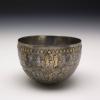Hemispherical bowl from Deve Hüyük
Commentary
Hemispherical bowl with vertical fluting in bronze from Deve Hüyük. Ashmolean 1913.676; P. R. S. Moorey, Cemeteries of the first millennium B.C., at Deve Hüyük (1980) cat. 86.
Plain hemispherical drinking-vessels with a rounded bottom, although not as common as the “Achaemenid bowl” with carination and flared lip, appear in elite assemblages throughout the Persian empire, and this should probably also be considered as a distinctively Achaemenid form. For plain silver examples, see II. Özgen & J. Öztürk, Heritage Recovered: The Lydian Treasure (1996) nos. 51 and 52 (from İkiztepe). A plain gold example from the Oxus treasure can be seen here (= J. Curtis and N. Tallis, Forgotten Empire: The World of Ancient Persia (2005) p.113 no. 99); the prescribed material on this page also includes another example from the British Museum, in silver with elaborate gold-figure appliqués. On the Persepolis Apadana reliefs, hemispherical bowls appear in the hands of the Parthian delegation (Delegation XIII): G. Walser, Die Völkerschaften auf den Reliefs von Persepolis (1966), Tafel 62. For brief discussion, see P.R.S. Moorey, ‘The technique of gold-figure decoration on Achaemenid silver vessels’, Iranica Antiqua 23 (1988), 233-4.

